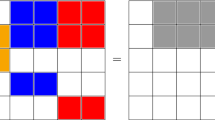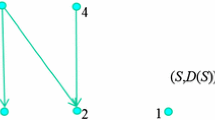Abstract
In many applications of cooperative game theory to economic allocation problems, such as river-, polluted river- and sequencing games, the game is totally positive (i.e., all dividends are nonnegative), and there is some ordering on the set of the players. A totally positive game has a nonempty core. In this paper we introduce constrained core solutions for totally positive games with ordered players which assign to every such a game a subset of the core. These solutions are based on the distribution of dividends taking into account the hierarchical ordering of the players. The Harsanyi constrained core of a totally positive game with ordered players is a subset of the core of the game and contains the Shapley value. For special orderings it coincides with the core or the Shapley value. The selectope constrained core is defined for acyclic orderings and yields a subset of the Harsanyi constrained core. We provide a characterization for both solutions.

Similar content being viewed by others
Notes
Finite totally positive games, as well as their infinite analogs, were introduced in Vasil’ev (1975).
A game \(v^*\) is the dual of a game \(v\) when \(v^*(S) = v(N) -v(N\setminus S)\) for every \(S \subseteq N.\)
We could easily define this solution on the class of all totally positive games with ordered players, assigning the empty set whenever the order \(D\) contains a cycle.
For single-valued solutions this is weaker than a similar property introduced in van den Brink and Gilles (1996) who do not require the predecessor to be necessary for the successor.
Here we should redefine efficiency, the null player property, additivity and nonnegativity for TU-games by adapting the corresponding axioms for games with ordered players in a straightforward way.
Note that this also follows immediately since a sharing system assigning zero shares to players that have predecessors in the corresponding coalition satisfies the restrictions of \(P^T_D.\)
A similar requirement for simple TU-games is discussed by Napel and Widgrén (2001).
However, a solution that satisfies structural exclusion and nonnegativity also satisfies structural monotonicity.
The condition that only connected coalitions have nonzero dividend also holds for restricted communication graph games, as introduced by Myerson (1977). Given a game and an undirected (communication) graph, Myerson defines the restricted game as the game which assigns to every coalition the sum of the worths of its maximally connected subsets in the graph.
To keep terminology consistent in this paper, we deviated from the terminology of Ni and Wang (2007) who refer to a cost allocation as a solution, and to a solution as a method.
Also, \(\widehat{v}\) is the dual auction game corresponding to the auction situation with \(\sum _{j=i}^n~c_j\) being the valuation of agent \(i\) for the object that is auctioned, see Graham et al. (1990).
These two axioms are already used by Ni and Wang (2007).
Note that on this subclass nonnegativity, meaning that every agent pays a nonnegative share in the cost, is not needed to get uniqueness. A proof can be obtained from the authors on request.
References
Ambec S, Sprumont Y (2002) Sharing a river. J Econ Theory 107:453–462
Brânzei R, Fragnelli V, Tijs S (2002) Tree connected line graph peer group situations and line graph peer group games. Math Method Oper Res 55:93–106
Curiel I, Pederzoli G, Tijs S (1989) Sequencing games. Eur J Oper Res 40:344–351
Demange G (2004) On group stability in hierarchies and networks. J Political Econ 112:754–778
Derks J, Haller H, Peters H (2000) The selectope for cooperative TU-games. Int J Game Theory 29:23–38
Gillies DB (1953) Some theorems on \(n\)-person games. PhD Thesis, Princeton University
Gilles RP, Owen G, van den Brink R (1992) Games with permission structures: the conjunctive approach. Int J Game Theory 20:277–293
Graham DA, Marshall RC, Richard J-F (1990) Differential payments within a bidder coalition and the Shapley value. Am Econ Rev 80:493–510
Hammer PL, Peled UN, Sorensen S (1977) Pseudo-Boolean functions and game theory. I. Core elements and Shapley value. Cah CERO 19:159–176
Harsanyi JC (1959) A bargaining model for cooperative n-person games. In: Tucker AW, Luce RD (eds) Contributions to the theory of games IV. Princeton University Press, Princeton, pp 325–355
Kalai E, Samet D (1987) On weighted Shapley values. Int J Game Theory 16:205–222
Kilgour DM, Dinar A (1995) Are stable agreements for sharing international river water now possible? Policy Research Working Paper 1474. World Bank, Washington
Littlechild SC, Owen G (1973) A simple expression for the Shapley value in a special case. Manag Sci 20:370–372
Maniquet F (2003) A characterization of the Shapley value in queueing problems. J Econ Theory 109: 90–103
Myerson RB (1977) Graphs and cooperation in games. Math Oper Res 2:225–229
Napel S, Widgrén M (2001) Inferior players in simple games. Int J Game Theory 30:209–220
Ni D, Wang Y (2007) Sharing a polluted river. Game Econ Behav 60:176–186
Shapley LS (1953) A value for N-person games. In: Kuhn HW, Tucker AW (eds) Contributions to the theory of games II. Princeton University Press, Princeton, pp 307–317
Smith W (1956) Various optimizers for single-stage production. Nav Res Logist Q 3:59–66
van den Brink R, Gilles RP (1996) Axiomatizations of the conjunctive permission value for games with permission structures. Game Econ Behav 12:113–126
van den Brink R, van der Laan G, Vasil’ev VA (2008) Extreme points of two polytopes associated with a digraph and applications to cooperative games. J Math Econ 44:1114–1125
van den Nouweland A, Borm P, van Golstein Brouwers W, Tijs S (1996) A game theoretic approach to problems in telecommunication. Manag Sci 42:294–303
Vasil’ev VA (1975) The Shapley value for cooperative games of bounded polynomial variation. Optim Vyp 17:5–27 (in Russian)
Vasil’ev VA (1978) Support function of the core of a convex game. Optim Vyp 21:30–35 (in Russian)
Vasil’ev VA (1981) On a class of imputations in cooperative games. Sov Math Dokl 23:53–57
Vasil’ev VA, van der Laan G (2002) The Harsanyi set for cooperative TU-games. Siberian Adv Math 12:97–125
Acknowledgments
This research has been done while the third author was visiting the Tinbergen Institute, VU University Amsterdam, on NWO-Grant 047.017.017 within the framework of Dutch-Russian Cooperation. This author also appreciates financial support from the Russian Leading Scientific Schools Fund (Grant 4113.2008.6) and Russian Fund for Basic Research (Grant 13-06-00311). We thank two anonymous referees and the associate editor for their valuable comments.
Author information
Authors and Affiliations
Corresponding author
Rights and permissions
About this article
Cite this article
van den Brink, R., van der Laan, G. & Vasil’ev, V.A. Constrained core solutions for totally positive games with ordered players. Int J Game Theory 43, 351–368 (2014). https://doi.org/10.1007/s00182-013-0382-x
Accepted:
Published:
Issue Date:
DOI: https://doi.org/10.1007/s00182-013-0382-x
Keywords
- Totally positive TU-game
- Digraph
- Harsanyi dividends
- Core
- Shapley value
- Harsanyi set
- Selectope
- Polluted river games




